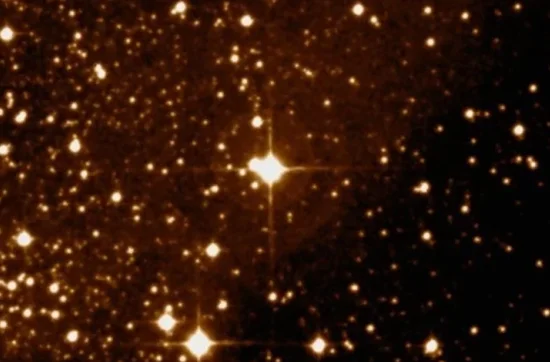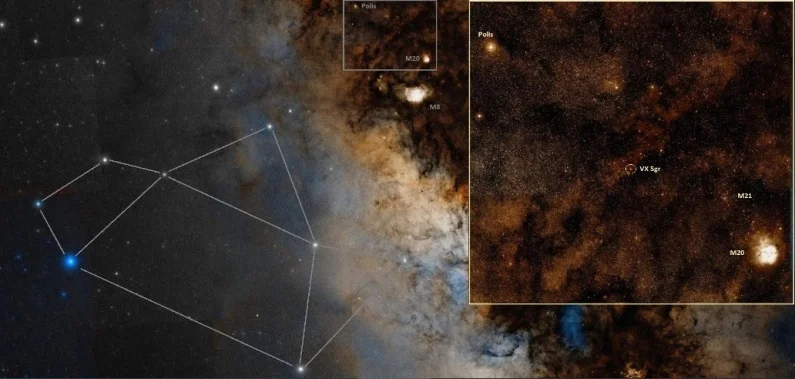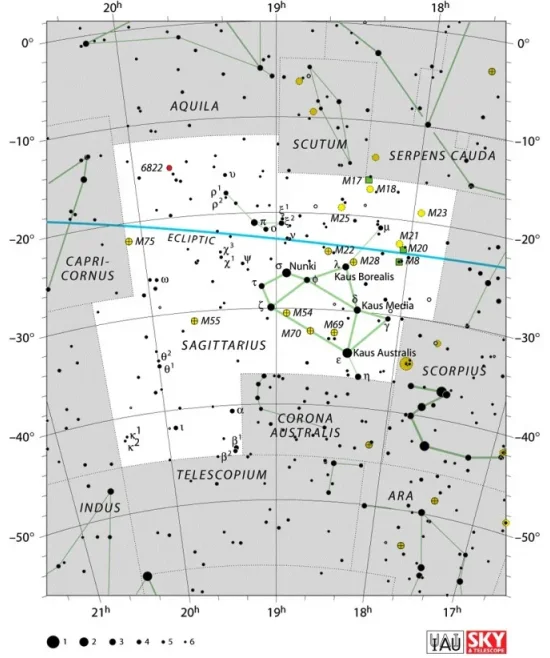VX Sagittarii is a red hypergiant star located in the southern constellation Sagittarius. It is one of the largest stars known, with a radius over a thousand times that of the Sun. With an apparent magnitude that varies from 6.5 to 14.0, the star is invisible to the unaided eye. It lies at an approximate distance of 5,100 light years from Earth.
Star type
VX Sagittarii is a luminous supergiant or hypergiant star of the spectral type M4eIa – M10eIa. The luminosity class Ia indicates a bright supergiant. VX Sgr has a mass 12 times that of the Sun. It is a pulsating variable star whose brightness oscillates with an unusually large amplitude, from magnitude 6.5 to 14.0.
The star’s radius, spectral type, temperature and luminosity all vary depending on the pulsation phase. As the star pulsates, its radius changes from 1,120 to 1,550 solar radii. At minimum light, VX Sgr shows the spectrum of a M9.8e class star and, at the maximum, its spectral type is M4e.

VX Sagittarii, image: Wikisky
VX Sagittarii has an estimated luminosity about 195,000 times that of the Sun, while its temperature varies from 2,900 K near the minimum to 3,200-3,400 K near the maximum. Temperatures in this range are similar to those of the coolest stars on the asymptotic giant branch (AGB) and highly unusual for a massive supergiant. A study published in 2009 demonstrated that the star’s atmosphere appears to resemble the atmospheres of Mira-type (AGB) stars more closely than those of red supergiants (RSG).
VX Sagittarii is losing mass due to powerful stellar winds, low surface gravity and high luminosity. By the end of its life, it will have lost a substantial portion of its initial mass. The mass of 12 solar masses seals the star’s ultimate fate. VX Sgr will end its life as a bright supernova.
VX Sagittarii is classified as a semiregular variable of the SRc type. It has a pulsation period of 732 days. It sometimes exhibits brightness variations with amplitudes similar to those of long period variables, while at other times the amplitudes are considerably smaller.
The stars in this class (SRc) are semiregular variable giants or supergiants of late spectral types whose brightness varies with an amplitude of about 1 magnitude over periods that range from 30 days to a few thousand days. Other semiregular stars of the SRc type include the red supergiants Betelgeuse in the constellation Orion, Mu Cephei (Garnet Star) in Cepheus, CE Tauri (119 Tauri) in Taurus, the bright giant or supergiant Rasalgethi in Hercules, and the bright giant T Ceti in Cetus.
Size
VX Sagittarii has a radius that varies from 1,120 to 1,550 solar radii. If placed in our solar system, the star would extend all the way to the orbit of Jupiter (1,064 – 1,173 R☉) and beyond.
VX Sgr is larger than HR 5171A (1,060 – 1,160 R☉), Betelgeuse (887 R☉), Antares (680 – 800 R☉), VV Cephei A (500 or 1,000 R☉) and Mu Cephei (972 – 1,260 R☉), but does not come close to the current record holders, Stephenson 2-18 (2,150 R☉) and MY Cephei (2,061 R☉), both of which would extend to the orbit of Saturn (1,940 – 2,169 R☉).
Earlier estimates of the size of VX Sagittarii were in the range from 1,350 to 1,940 solar radii.
Facts
The parallax of VX Sagittarii has been measured at 0.64 ± 0.06 milliarcseconds using the Very Long Baseline Array (VLBA), an array of 10 radio telescopes that work together and are the longest system in the world to perform very-long-baseline interferometry (VLBI). The parallax yielded a distance of 5,100 light years. The same study derived a bolometric luminosity of 195,000 ± 62000 L⊙ and measured the star’s proper motion at 0.36 ± 0.76 and −2.92 ± 0.78 mas yr−1. Both the parallax and proper motion of VX Sagittarii are consistent with membership in the Sagittarius OB1 association.
VX Sagittarii has a highly irregular circumstellar envelope that changes as the star pulsates. Observations with the Very Long Baseline Array (VLBA) in the 1990s revealed SiO maser emission lines appearing in a ring with a radius of 1.4 solar radii in the extended atmosphere. The observations also revealed molecular water layers which, together with masers, are commonly found in OH/IR stars (stars in the late stages of the asymptotic giant branch). In 2007, a study used the masers to derive an accurate distance of 1.57 ± 0.27 kiloparsecs.
Location
VX Sagittarii lies above the Teapot, an asterism formed by the brightest stars in Sagittarius, in the region between the star Polis (Mu Sagittarii, mag. 3.85), a blue supergiant, and the Trifid Nebula (Messier 20), a bright star-forming nebula.

VX Sagittarii location, image: Wikisky
The brightness of VX Sagittarii varies from 6.5 to 14.0, which means that even at its brightest the star is only theoretically visible in exceptionally good conditions. Most of the time, VX Sgr requires binoculars or a telescope to be seen.
Constellation
VX Sagittarii is located in the constellation Sagittarius. Representing the celestial Archer, Sagittarius is one of the 48 Greek constellations, first listed by the astronomer Claudius Ptolemy of Alexandria in his Almagest in the 2nd century CE. The constellation is usually depicted as a centaur holding a bow, outlined by the bright stars Kaus Borealis, Kaus Media, and Kaus Australis.

Sagittarius constellation map by IAU and Sky&Telescope magazine
Sagittarius is one of the larger constellations – the 15th in size out of 88 – stretching across 867 degrees of the southern sky. It contains 15 Messier objects, more than any other constellation. These include the globular clusters Messier 22, Messier 28, Messier 54, Messier 55, Messier 69 and Messier 75, the open clusters Messier 23 and Messier 25, the Milky Way star cloud Messier 24 (Sagittarius Star Cloud), and the bright, large nebulae known as the Lagoon Nebula (Messier 8), the Omega Nebula (Messier 17), and the Trifid Nebula (Messier 20).
The constellation is also home to the planetary nebulae NGC 6537 (the Red Spider Nebula), M 1-42 (the Eye of Sauron Nebula), NGC 6818 (the Little Gem Nebula), and NGC 6445 (the Box Nebula), the star-forming nebula NGC 6559, the Sagittarius Dwarf Elliptical Galaxy (Sag DEG), a satellite galaxy of the Milky Way, and the Arches Cluster, the densest cluster known in our galaxy.
Notable stars in Sagittarius include the blue hypergiant V4647 Sagittarii (Pistol Star) and the Wolf-Rayet star WR 102ka (Peony Star), both among the most luminous stars ever discovered. The constellation also contains the red supergiant KW Sagittarii, one of the largest stars known.
The best time of year to observe the stars and deep sky objects in Sagittarius is during the month of August, when the constellation is prominent in the evening sky. The entire constellation is visible from locations between the latitudes 55° N and 90° S.
The 10 brightest stars in Sagittarius are Kaus Australis (Epsilon Sgr, mag. 1.85), Nunki (Sigma Sgr, mag. 2.05), Ascella (Zeta Sgr, mag. 2.59), Kaus Media (Delta Sgr, mag. 2.70), Kaus Borealis (Lambda Sgr, mag. 2.82), Albaldah (Pi Sgr, mag. 2.89), Alnasl (Gamma² Sgr, mag. 2.98), Eta Sagittarii (mag. 3.11), Phi Sagittarii (mag. 3.17), and Tau Sagittarii (mag. 3.326).
VX Sagittarii
| Spectral class | M4eIa – M10eIa |
| Variable type | Semiregular variable (SRc) |
| Apparent magnitude (V) | 6.5 – 14.0 |
| Apparent magnitude (U) | 11.72 |
| Apparent magnitude (B) | 9.41 |
| Apparent magnitude (V) | 6.52 |
| Apparent magnitude (I) | 2.11 |
| Apparent magnitude (J) | 1.23 |
| Apparent magnitude (H) | 0.13 |
| Apparent magnitude (K) | -0.50 |
| Apparent magnitude (L) | -1.61 |
| Distance | 5,100 ± 300 light years (1,560 ± 100 parsecs) |
| Parallax | 0.64 ± 0.04 mas |
| Radial velocity | +6.47 ± 3.37 km/s |
| Proper motion | RA: +0.36 ± 0.76 mas/yr |
| Dec.: −2.92 ± 0.78 mas/yr | |
| Mass | 12 M☉ |
| Luminosity | 195,000 ± 62,000 L☉ or 110,000–190,000 L☉ |
| Radius | 853 R☉ or 1,120 – 1,550 R☉ or 1,350 – 1,940 R☉ |
| Temperature | 2,900 K (near minimum), 3,200 – 3,400 (near maximum) or 2,400 – 3,300 K |
| Constellation | Sagittarius |
| Right ascension | 18h 08m 04.0431479808s |
| Declination | −22° 13′ 26.629744195’’ |
| Names and designations | VX Sagittarii, VX Sgr, HD 165674, HIP 88838, CD−22°12589, BD−22°4575, AAVSO 1802-22, 2MASS J18080404-2213266, GSC 06276-00721, IRAS 18050-2213, JP11 2930, UBV M 22627, RAFGL 2071, UCAC2 22972679, TYC 6276-721-1, Gaia DR2 4069737050648231424 |